Garlic Mustard (Jack-By-The-Hedges)
By Mike on Sunday, April 20, 2008, 23:57 - Permalink
 Garlic Mustard (Also known as Hedge Mustard, Sauce-All-Alone and Poor Man's Mustard) is a common plant of hedgerows, roadsides and wood edges - and the diversity of common names suggests this has historically been a widely-consumed wild food. So... what's it like?
Garlic Mustard (Also known as Hedge Mustard, Sauce-All-Alone and Poor Man's Mustard) is a common plant of hedgerows, roadsides and wood edges - and the diversity of common names suggests this has historically been a widely-consumed wild food. So... what's it like?
I was out in search of morels (returning home with none, although I did find a small patch of St George's Mushrooms). I spotted lots of Garlic Mustard along the road and field edges, so I thought it was maybe time to give this a try.
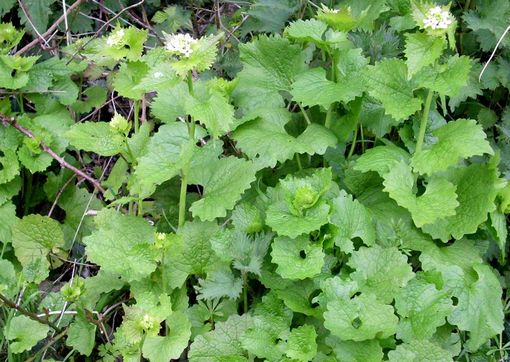
What is Garlic Mustard?
Alliaria petiolata - Some of the common names are a bit misleading, as this plant isn't at all closely related to garlic - it's in the same family as radishes and cabbage (Cruciferae)
Despite being unrelated, the plant really does smell quite strikingly of garlic when crushed.
Other common names for this plant are Hedge Mustard, Sauce-All-Alone and Poor Man's Mustard
Picking Garlic Mustard
The plant is very common by roadside hedges, although this probably isn't the best place to pick it, due to contaminants from vehicle exhaust and general road grime - but it can also be found at field edges and in open woodland.
Perhaps there are other reasons to be discerning about where to pick this plant - see the footnote to the right
It's probably best picked at or before the time where the first cluster of flowers appears - after that, it quickly becomes tough and wiry.
In The Kitchen
All of my wild food books praise this plant as a useful and versatile green vegetable.
I'm sorry to say that this is an opinion I cannot at this time endorse - I didn't find this one pleasant at all (scroll down for more)
Cooking
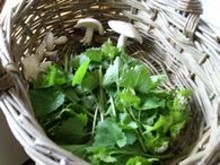 I picked a big handful of tender tops (seen here in my basket with St George's Mushrooms)
I picked a big handful of tender tops (seen here in my basket with St George's Mushrooms)
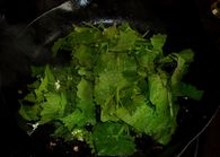
I rinsed them, then chopped them and threw them into a hot pan in which bacon had previously been fried
I covered this with a lid and allowed the leaves to steam and wilt.
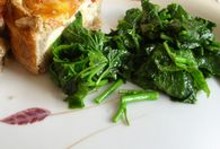 Cooked, they look pretty appetising - here they are alongside the quiche I made with the mushrooms...
Cooked, they look pretty appetising - here they are alongside the quiche I made with the mushrooms...
However...
As a vegetable, I'm afraid this one gets the thumbs down - texture wasn't bad, but the taste was horribly, inedibly bitter - not nice at all. Shame, because it's an easy plant to identify and gather, but there you go.
Footnote
I have since been told that the growing conditions in which the plant is found can have a significant effect on the flavour, and that specimens growing in the dryish nutrient-starved conditions under a hedge may be the most bitter.
Maybe I'll have to give it another try - so just to be fair - it gets added back to my list (at the bottom).
Update April 2013
A slow, late spring that started bitterly cold has yielded a lush crop of foliage growth, including roadside hedgerows crammed with Garlic Mustard.
Last time I tried this, I found it inedibly bitter, but as this plant has a long-standing reputation as a vegetable, I thought it was worth another try.
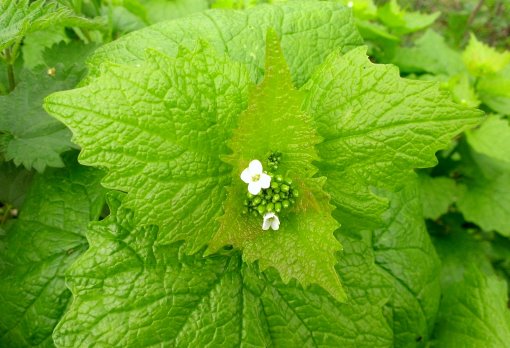
Where To Find It
 Garlic Mustard is most commonly seen on roadsides, especially alongside woodland, but this is not a good place to actually harvest it - although nowadays, all the cars are burning unleaded fuels, there are still contaminants such as oils, brake dust and tyre residues - even just plain old dirt and grit that can be deposited by traffic onto roadside plants.
Garlic Mustard is most commonly seen on roadsides, especially alongside woodland, but this is not a good place to actually harvest it - although nowadays, all the cars are burning unleaded fuels, there are still contaminants such as oils, brake dust and tyre residues - even just plain old dirt and grit that can be deposited by traffic onto roadside plants.
However, the roadside is a great place to learn to identify plants, making them easier to find elsewhere.
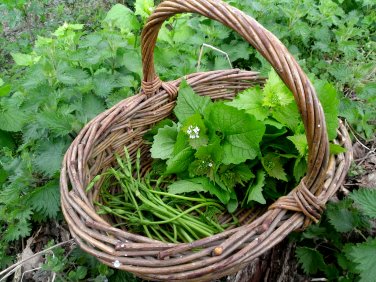 Eventually, I found a patch of woodland away from the road with some nice-looking garlic mustard plants with nice intact leaves and thick, soft stems.
Eventually, I found a patch of woodland away from the road with some nice-looking garlic mustard plants with nice intact leaves and thick, soft stems.
I picked a nice bunch of tender tops from the best-looking plants (the other things in the basket here are the tips of hop shoots).
 Soft, leafy plants like these will wilt very fast once picked, and as I harvested them early in the afternoon, I stood them in a glass of water to keep them nice and fresh until I needed to cook them.
Soft, leafy plants like these will wilt very fast once picked, and as I harvested them early in the afternoon, I stood them in a glass of water to keep them nice and fresh until I needed to cook them.
 Last time I ate this plant, I cooked it by frying it and wilting it down. This time, I heated a pan of water, then dropped the washed leaves in and quickly boiled them for about five minutes.
Last time I ate this plant, I cooked it by frying it and wilting it down. This time, I heated a pan of water, then dropped the washed leaves in and quickly boiled them for about five minutes.
After cooking, I drained the leaves in a colander and rinsed with additional boiling water - the idea being to rid it of some of bitterness.
The Verdict This Time
Better than last time. Still quite strongly bitter, but edible with sauce or gravy, however, the bitter taste lingered in my mouth for quite a while after finishing the meal.
So... I don't think I'll bother with this again - given that other, better wild vegetables (for example stinging nettles) are abundantly available at the same time, I don't really see the point in picking this one.
Still A Disappointment
Well, that's twice I've tried this, and although the second time was better, I'm still not convinced that this is a really worthwhile vegetable.
However, I try to keep an open mind - so if you've tried this and enjoyed it, maybe I'm just doing something wrong - so please let me know...
